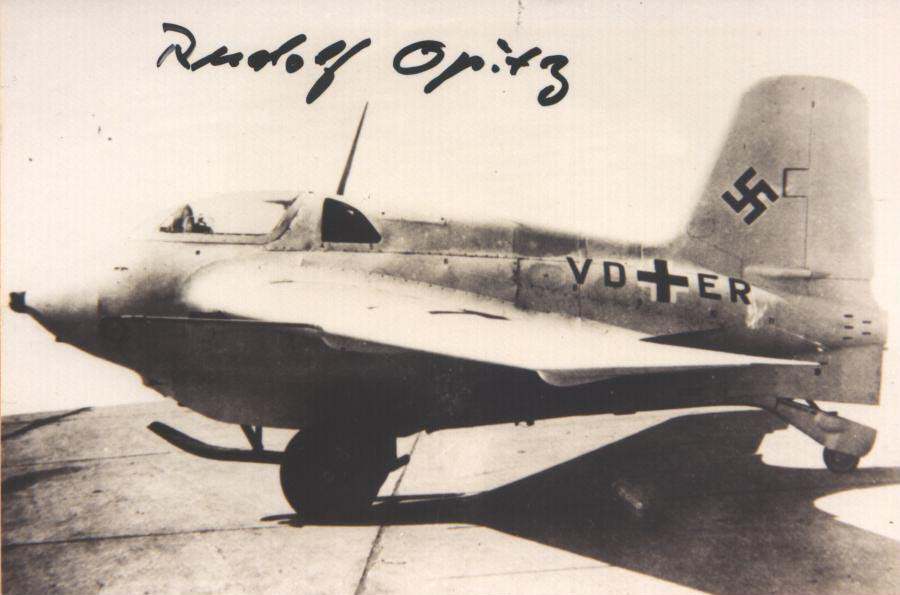|
|

|
~SOLD~OPITZ Rudolf
Rudolf Opitz
German glider and test pilot of WWII
He was one of the three original glider instructors to teach the first German military glider pilots how to fly at the DFS ("Deutsche Forschungsanstalt für Segelflug" or the "official" German Flight Research Institute for Gliders) in 1936-38.
Born in Landeshut, Germany in 1910, Rudolf Opitz joined a flying club in 1929 and began flying gliders. In 1934 he became an instructor at Germanys famous glider school at Wasserkuppe in the Rhoen Mountains. Later he joined the German Research Institute as a flight instructor for cargo gliders and airplanes. From 1936 to 1939 Rudy was involved as the test pilot for a research team working on flying wing designs. In 1939 he was drafted into the Luftwaffe, and in 1940 he flew his first combat mission as an assault glider pilot on a mission to capture and secure three strategic bridges over the Albert Canal. In 1941 Opitz was assigned to the German Rocket Research Center at Peenemuende. He was assigned as a test pilot to the Me-163A Komet. In 1942 Rudy would make the worlds first flight in a rocket powered fighter aircraft, the Me-163B. In 1944 he was assigned as Commander of the IIJG/400 Rocket Fighter Group. Rudy met Herman Goering once at an exclusive airshow for high ranking military and government officials. All the latest designs were displayed, and Goering stopped by each aircraft to personally speak with their pilots and crews. Rudy, as the Chief Test Pilot for the 163 program was a bit surprised when Goering asked him, Were you drafted to serve in the rocket fighter squadron or did you volunteer to fly this aircraft? On Rudys last flight in the 163, the fire warning light came on immediately after take off. Rudy began to jettison fuel, but the cockpit filled with burning fuel vapors. Rudy jettisoned the canopy and somehow managed to bring the 163 down in a meadow near the airfield. Despite being injured Rudy managed to get out of the burning aircraft before it exploded. During his recovery Rudy met a nurse, Hanna, who would become his wife after the war. Opitz moved to the U.S. following the War. He continued his career as a test pilot for the Aeronautical Research and Development Center at Wright Patterson AF13 in Ohio. He also worked with the gas turbine division of Avco Lycoming. For more than three decades Opitz served as a FAA pilot examiner for private commercial and flight- instructor certificates. In 1984 he was elected and certified as an Honorary Fellow of the Society of Experimental Test Pilots. In 1994 he was elected into the United States Soaring Hall of Fame. Although 86-years young at the time of this writing, Rudy continues his life long enthusiasm for flight, and still works with aspiring young pilots at his local soaring club in Connecticut. The tremendous technological breakthroughs embodied in the Me-262 and Me-163 development programs accelerated the development of modem rocket and jet powered aircraft by compressing decades of normal development time into a few intense wartime years. Rudy Opitz and his fellow test pilots, many who gave their lives in the process, were critical to the successful development of these programs. Rudolf Opitz passed away in May 2010.
Rocket-powered Me-163 Comet, probably the most technically advanced aircraft of the second world war. Out of necessity, German aircraft designers compressed decades of development time into years or often months. Although it did not play a significant role in combat, the 163 represented a radical departure from conventional aircraft design. With a length of only 19 feet, the diminutive 163 was powered by a liquid fuel rocket engine. The production models of the Comet were fueled with a mixture of C-Stoff (a mixture of 57% methyl alcohol, 13% hydrazine hydrate, and 13% water) and T-Stoff which was 80% hydrogen peroxide. Almost 5000 pounds of fuel were carried, but the Comets engine had a burn time of only a few minutes. Many technological breakthroughs were required for the Comet program to succeed. Because space and weight were so critical, use of a conventional landing gear was not possible. Instead the 163 utilized a simple dolly consisting of an axle and two wheels which was jettisoned upon takeoff. For landing the 163 utilized a sturdy retractable skid with hydraulic shock absorbers. The Comet was also not particularly effective in combat despite its 596-MPH top speed and twin canon. The aircraft had only about 150 seconds of power once it reached altitude. Thereafter it became a very fast glider. Allied pilots learned to exploit the 163s vulnerability during landing.
Postwar 4” x 6” signed photo of a Me163
Price: $0.00
Please contact us before ordering to confirm availability and shipping costs.
Buy now with your credit card
other ways to buy
|
|


